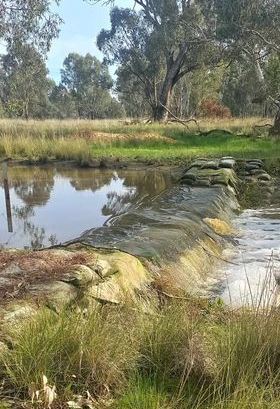Wetland restoration updates at a glance – Mt Burr Swamp (SA) and Rowan Swamp (Vic)
Over recent days, I had a chance to swing past the Mt Burr Swamp stage 2 wetland restoration area, and check to see how things are looking six months after remedial works concluded. The best perspective to show the change over this time is shown in the sequence of images below, looking west over the Stage 2 area, with Mt Burr Swamp proper in the background.
First up, here is the area in May, as drain backfilling was underway…
Next up, we have the same view, a couple of months later in mid-July, after the extreme early winter rainfall in June that absolutely soaked this part of the landscape…
And finally, here is the same view taken a few days ago (note: given the angle of the afternoon sun, the water in the wetlands is reflecting sunlight so appears white).
Despite a few very dry months (up until the rain of the past few weeks), the restored wetland basins through the Stage 2 area are all looking magnificent and have slowly receding water levels as the warmer months arrive. With the drains through this area now remediated, no surface water is currently leaving the site and these restored natural wetlands – which are retaining sustained surface inundation – will help to buffer the local shallow, perched groundwater aquifer. Notice how adjacent drained wetlands next door in the right of the image (ignoring the dam) were temporarily inundated in July, and are now dry? Whilst the restored wetlands within the Mt Burr Swamp Restoration Reserve are still holding water.
Heading into the summer, this Stage 2 area of our Reserve at Mt Burr Swamp is an illustration of what the ‘recharge farm’ concept looks like in practice!
Meanwhile, a little further west on the Reserve at Mt Burr Swamp proper, which was restored in 2016, and this wetland is also looking magnificent – holding more water at this time of year than at any other time since it was restored in 2016. Thanks to the wet start to the winter triggering this sustained level of inundation, we expect to see some more spontaneous recovery of fringing wetland vegetation (coupled with displacement of introduced plants) around this year’s high water mark.
Given the success of the restoration works at Mt Burr Swamp, Bryan tells me that the bird list on the Reserve continues to grow and that there are a lot of birds using these wetlands this year – in both species diversity and numbers. For more details, take a look at Bryan’s blog this month.
Finally – I missed reporting it in November, but several weeks ago in late October, I was able to drop in at Rowan Swamp (near Benalla) to see how the ongoing restoration trial was looking – and I was not disappointed!
The wetland was teeming with life and covered in lush aquatic native vegetation, thriving as a result of the more consistent and sustained inundation pattern made possible by the trial structure, which is retaining water for a more prolonged period in the wetland after each flow event.


Thanks to a nice top-up rainfall event in earlier October, at the time of my visit the wetland was sitting near its restored sill level, with a small outflow trickling over the trial structure, as shown below. The difference in elevation either side of the trial structure indicates the important role this is having in retaining water in the swamp, by negating the impacts of past erosion in the outlet channel.

In terms of ecological benefits from the trial, we heard via a comment by David Cox on our Facebook page that some waterbird breeding attempts in the past have failed in the wetland as a result of inundation not being sustained long enough because of the eroded outlet artificially drying the wetland out too rapidly after inflows cease. David wrote: “The Blue-winged Shoveler that have tried to nest there in the past, will now be very happy that there will be enough water for their broods to make it to fledging.” He also provided an image of the flow over the trial structure back in July that we have also shared here.
We definitely agree that these and many other species of waterbirds will be happy! Extending the period of inundation in a wetland that has been modified (through erosion or artificial drainage) by even as little as a few weeks can have huge benefits for the wide range of species that depend on these wetlands for completing a successful attempt at breeding and recruitment.
Stay tuned in 2024 for more updates on these and other wetlands previously restored by NGT!
Nature Glenelg Trust acknowledges:
The project at Mt Burr Swamp was supported by the Limestone Coast Landscape Board, through funding from the South Australian Government’s Landscape Priorities Fund and the Australian Government’s National Water Grid Connections Funding Pathway.
This project at Rowan Swamp was supported through funding from the Australian Government’s Murray–Darling Healthy Rivers Program and Parks Victoria.





